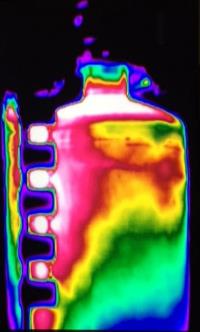A newly installed melter at the Defense Waste Processing Facility at the US Department of Energy's Savannah River site has poured its first canisters of vitrified radioactive waste.
 |
| An infrared image of the first new canister being filled by the melter on 1 January (Image: Savannah River Site) |
The melter treats high-level radioactive waste, currently stored in tanks at the South Carolina site, by blending it with a borosilicate glass known as "frit" to form a molten glass mixture. The vitrified mixture is then poured into stainless steel canisters. Thus stabilised, the vitrified waste can then be safely stored onsite until a permanent disposal facility is available.
The new melter was installed by liquid waste contractor Savannah River Remediation (SRR). It is the third melter in the 20-year history of the facility, and replaced Melter 2 which reached the end of its operational life in 2017 after 14 years of operation. In that time, Melter 2 poured 10. 8 million pounds (4900 tonnes) of glass into 2819 canisters.
Melter replacements are built into the overall plan for liquid waste treatment at Savannah River. SRR president and project manager Tom Ford said the company had optimised the system outage to replace the melter and perform other critical facility upgrades, integrating the schedule with a separate planned outage to tie in the Salt Waste Processing Facility (SWPF) into current liquid waste facilities. The SWPF, which is undergoing commissioning and testing, will process low-level salt waste which accounts for more than 90% of the wastes held in Savannah River's tanks.
The Savannah River Site was built in the 1950s to produce the basic materials used in the fabrication of nuclear weapons, primarily tritium and plutonium-239. Five reactors were built on the site as well as support facilities including two chemical separations plants, a water extraction plant, a nuclear fuel and target fabrication facility and waste management facilities.
Researched and written
by World Nuclear News




_18570.jpg)
_18938.jpg)
_33584.jpg)
_82983.jpg)





